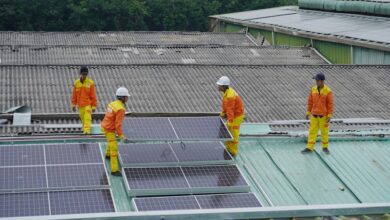Powering the Future: Navigating the Renewable Energy Landscape and the Transition to a Sustainable Economy

The transition to renewable energy has become a defining feature of the 21st century, as societies around the globe seek to mitigate climate change and reduce their dependence on fossil fuels. With solar, wind, and hydrogen power leading the charge, the renewable energy sector is witnessing unprecedented growth, fueled by technological advancements and shifting consumer preferences. Governments are playing a pivotal role in this transformation by implementing policies and incentives designed to accelerate clean energy adoption. However, this transition is not without its challenges; energy storage remains a critical hurdle that must be addressed to ensure a reliable and sustainable energy future. As the landscape evolves, the future of nuclear energy is also being reconsidered within the context of a low-carbon world, while traditional oil and gas companies are exploring new strategies to adapt to changing market dynamics. Additionally, the rise of electric vehicles is poised to further reduce fossil fuel dependency, all while economic fluctuations in energy prices continue to impact global markets. This article delves into these interconnected themes, exploring the innovations in energy efficiency that hold the potential for significant cost savings and a brighter, cleaner future for all.
- 1. **Harnessing Nature: The Surge of Solar, Wind, and Hydrogen Energy**
- 2. **Policy Power: Government Incentives Driving the Clean Energy Revolution**
1. **Harnessing Nature: The Surge of Solar, Wind, and Hydrogen Energy**
The transition to renewable energy is predominantly marked by the rise of solar, wind, and hydrogen power, each harnessing natural resources to provide sustainable energy solutions. Solar energy has gained significant traction due to advancements in photovoltaic technology, making it more efficient and affordable. This has led to a dramatic increase in solar installations worldwide, driven by both individual homeowners and large-scale solar farms. The ability to generate electricity directly from sunlight not only reduces dependence on fossil fuels but also empowers communities to achieve energy independence.
Wind energy, similarly, has experienced remarkable growth, powered by innovations in turbine design and efficiency. Onshore and offshore wind farms are becoming commonplace, contributing to a substantial share of energy production in several countries. The scalability of wind energy allows for integration into diverse landscapes, making it a flexible option for both urban and rural areas. Governments are increasingly incentivizing wind energy through subsidies and tax breaks, further accelerating its adoption.
Hydrogen energy, often seen as a game-changer in the quest for clean energy, presents unique opportunities and challenges. Green hydrogen, produced through electrolysis powered by renewable sources, offers a zero-emission alternative for sectors that are hard to decarbonize, such as heavy industry and transportation. As research into hydrogen production and storage technologies advances, this versatile energy carrier could play a pivotal role in a future low-carbon economy.
In summary, the surge in solar, wind, and hydrogen energy reflects a broader commitment to harnessing nature's resources to combat climate change, reduce carbon emissions, and create a sustainable energy future. The interplay of these technologies not only enhances energy security but also fosters economic growth through job creation and innovation in the renewable sector.
The transition to renewable energy has gained significant momentum in recent years, driven by a combination of technological advancements, government policies, and public awareness of climate change. Solar and wind power have emerged as frontrunners in this shift, with countries investing heavily in infrastructure and incentives to promote their adoption. For instance, feed-in tariffs, tax credits, and grants are commonly used to encourage both businesses and households to invest in renewable energy systems. Governments around the world are also setting ambitious targets for carbon neutrality, further accelerating the deployment of clean energy technologies.
However, one of the critical challenges facing renewable energy is energy storage. As solar and wind energy are inherently intermittent, effective storage solutions are necessary to ensure a stable energy supply. Current technologies, such as batteries and pumped hydro storage, are improving but still face limitations in terms of capacity, cost, and scalability. Research into advanced storage solutions, including hydrogen fuel cells and thermal storage, is essential to address these challenges and facilitate a more reliable renewable energy grid.
In parallel, the role of nuclear energy in a low-carbon future is being re-evaluated. Nuclear power offers a consistent energy supply and low greenhouse gas emissions, making it a potentially vital component of the energy mix. However, concerns about safety, waste management, and public perception continue to pose hurdles to its widespread acceptance.
As the energy landscape evolves, traditional oil and gas companies are also adapting to the energy transition. Many are diversifying their portfolios by investing in renewable energy projects and technologies, aiming to reduce their carbon footprints and remain competitive in a changing market. This shift is further supported by the increasing significance of electric vehicles (EVs), which play a crucial role in diminishing reliance on fossil fuels. As charging infrastructure expands and battery technology improves, the adoption of EVs is expected to rise, contributing to lower emissions in the transportation sector.
Energy price fluctuations can significantly impact economies, influencing everything from consumer behavior to investment patterns. As renewable energy becomes more prevalent, it is anticipated that these fluctuations may stabilize over time, particularly as energy markets adapt to a larger share of renewables. Innovations in energy efficiency will also play a crucial role in this transition. By optimizing energy use across industries and homes, these innovations can lead to substantial cost savings and a reduction in overall energy demand, further supporting the shift to a sustainable energy future.
2. **Policy Power: Government Incentives Driving the Clean Energy Revolution**
Governments around the world play a crucial role in accelerating the transition to renewable energy through a variety of incentives and policies. These initiatives are designed to lower the barriers to entry for clean energy technologies, stimulate investment, and promote the adoption of sustainable practices among businesses and consumers.
One of the most effective tools in this policy arsenal is financial incentives, such as tax credits, grants, and subsidies. For instance, in countries like the United States, the Investment Tax Credit (ITC) and the Production Tax Credit (PTC) have significantly boosted solar and wind energy projects by providing substantial financial support. Similarly, many European nations offer feed-in tariffs or power purchase agreements that guarantee fixed prices for renewable energy producers, ensuring a stable revenue stream that encourages investment.
In addition to financial incentives, governments are increasingly implementing regulatory measures that favor renewable energy sources. Renewable portfolio standards (RPS) require utilities to obtain a certain percentage of their energy from renewable sources, driving demand for clean energy technologies. Furthermore, many jurisdictions are setting ambitious greenhouse gas reduction targets, which necessitate the rapid scaling of renewable energy infrastructure.
International cooperation also plays a vital role in promoting clean energy. Agreements such as the Paris Accord encourage nations to commit to reducing emissions and transitioning to renewable energy sources. Collaborative efforts, such as technology transfer and joint research initiatives, enable countries to share knowledge and resources, further accelerating the adoption of clean energy solutions.
Despite these positive developments, challenges remain. Policymakers must navigate the complexities of energy markets, address public concerns about land use and environmental impacts, and ensure that the transition to renewable energy is equitable and inclusive. By continuing to refine and enhance their policies, governments can create a robust framework that supports the clean energy revolution while addressing the pressing challenges of climate change.
In conclusion, the transition to renewable energy represents a pivotal shift in our approach to power generation and consumption. As we harness the abundant resources of solar, wind, and hydrogen, governments worldwide are playing a crucial role by implementing incentives that encourage investment and innovation in clean energy. However, challenges such as energy storage must be addressed to ensure a reliable and resilient energy supply.
The future of nuclear energy also holds promise as part of a diversified low-carbon energy portfolio, while traditional oil and gas companies are increasingly adapting their strategies to align with the evolving landscape. Furthermore, the rise of electric vehicles stands as a testament to our commitment to reducing fossil fuel dependency, contributing to cleaner air and lower greenhouse gas emissions.
Amidst this transition, economic factors, including energy price fluctuations, will continue to influence the market and consumer behavior. Innovations in energy efficiency present exciting opportunities for cost savings and environmental benefits, further underscoring the importance of a holistic approach to energy transformation.
Ultimately, the path to a sustainable energy future is complex and multifaceted, but with continued collaboration, innovation, and commitment, we can navigate these challenges and embrace a cleaner, more resilient energy system for generations to come.





